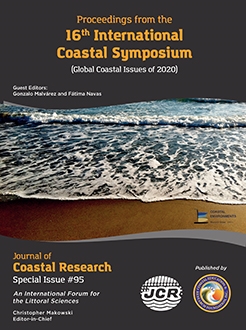Choi, J.H.; Kin, S.D.; Jun, K.W.; Lee, H.J., and Tak, W.J., 2020. Analysis of the topography change using the RAMMS Model and numerical modeling in the Korean East Sea Estuary. In: Malvárez, G. and Navas, F. (eds.), Global Coastal Issues of 2020. Journal of Coastal Research, Special Issue No. 95, pp. 422–427. Coconut Creek (Florida), ISSN 0749-0208.
Recently, erosion and sedimentation imbalances have occurred on many coastlines due to the complex effects of man-made environment changes and natural environment changes caused by climate change. Problems including coastal erosion, shoreline topography changes, and estuary blockages require comprehensive management of sediments including coastal sediments and those discharged from rivers and mountains in the hinterland. This study quantitatively investigated the streamflow of sediments generated from mountains and examined the effect of discharged sediments on coastlines and beaches. First, the sediments in rivers and beaches from mountain areas were investigated on-site using terrestrial LiDAR. High-precision topography data were constructed by generating Digital Elevation Model (DEM). To calculate the amount of sediment discharged from mountain areas quantitatively by using constructed topography data, simulations were performed with the RAMMS model, a type of sediment-water flow analysis model. By applying an erosion and sedimentation model, the effects on the beach topography along the coast were analyzed. It was confirmed through the RAMMS model that the sediment flowed into the river when a mountainous disaster, such as landslide or debris-flow, occurred. The sediment that flowed into the river induced coastline and beach topography changes. In terms of the beach topography on the East Coast of South Korea, the north side of the estuary beach showed a significant sedimentation tendency and the south side of the beach showed a gradual erosion tendency. Furthermore, significant changes in the coastline were observed as a river-mouth blockage occurred at the estuary due to sediments deposited from the mountains and rivers in the coastal area. It is expected that the results of this study will provide useful information when establishing plans for the preservation of coastal areas in the future.





